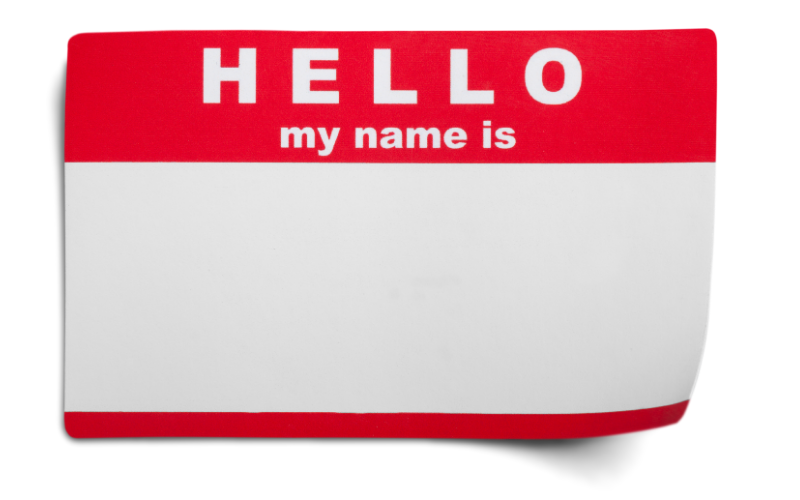Names Matter: How to Choose a Great Brand or Product Name
September 3, 2020 at 4:48 PM

"What's in a name? That which we call a rose by any other name would smell as sweet..."
So insists the naive Juliet in Act II of Shakespeare's Romeo and Juliet, implying, in this case, that a name holds little value, while love and an individual's worth is what counts in the end. Not one to be so bold as to contradict the Bard, I counter�more than four centuries later�that there's actually a great deal of importance in a name.
In fact, names matter. Big time.
If they didn't, new parents wouldn't spend countless hours perusing baby name books or researching the origins of names before the birth of their firstborn babies, nor would people grapple with the task of coming up with the perfect name for their new puppy, kitten or pet iguana.
Names are often chosen because they have special significance�frequently after a loved one, but sometimes after a favorite place (say, Wrigley or Fenway) or even team (like Dodger).
Dale Carnegie, author and lecturer, once said:
"A person's name is to him or her the sweetest and most important sound in any language."
There are myriad reasons why people choose the names they select for their children and pets, and with good reason. Those monikers, in all likelihood, will follow them for life!
That's why with any new product, service or company launch, it's critical to put the research, time, and thought into its name before "the big reveal."
It would be a terrible disservice�and potential disaster�if you didn't.
It would be like repainting a room covered in layers of wallpaper without doing the proper prep work.

You'd never simply paint without first taking the time to properly strip off the old wallpaper, spackle, sand, rinse, seal with primer and then apply that beautiful coat of fresh paint. It's 80% prep work, 20% actual painting to that glorious, finished product.
Why are we talking about painting a room when we're really discussing naming a new product?
Because you want and need a great new product or service name that will be successful�one that suits the product, resonates with the buyer and has the longevity it needs to survive.
And getting to that "glorious, finished product" requires putting in the necessary (albeit figurative) elbow grease and time to ensure you hit on a winning name.
So roll up your sleeves for that all-important prep work�before taking that first brush stroke�in naming your new product, service or company.
Lay the Foundation
First, you need to start the prep work.
Let's look at the 5 steps to take before brainstorming a name:
- Define your product, service or company: understand exactly what it is that you are bringing to the marketplace. Be specific and concise (think elevator speech).
- Define the market: who will be buying your product or service? Can you easily construct a persona of someone who fits the primary target audience? How about that of someone in the secondary target audience? Is there a strong commonality between the two?
- Market research: chances are, if you are bringing a new product or service to market, you've already conducted some research that reveals you've got a solution to a problem or something that addresses a specific need out there. Highlight the key results that could help you come up with a name.
- Competitive factors: you need to clearly understand who's already out there with a similar product or service, and what they bring to the table. What makes them #1 or #2 in current customers' minds? What is that company's price point? Do they offer a money-back guarantee? How are they known for customer service? This is the time to highlight the key benefits or features of your new product/service.
- Positioning platform: now that you've...
a) defined your target audiences;
b) outlined the problem/solution your new product/service addresses; and
c) highlighted key benefits and features�it's time to write your positioning statement. This positioning statement should differentiate your product or service enough from the competition to not only properly place your brand within the market, but also resonate with and attract customers. Defining this "promise" to your customers is key before any naming brainstorming can begin.
Let the Ideation Begin
Having laid the foundation through your prep work, it's now time to start the brainstorming process. This is the "anything goes" stage�or nearly so. Meaning, now's not the time to eliminate, but instead the goal is to get as many different ideas generated�perhaps hundreds�from which a more select list can later be culled for consideration.
You will find names typically fall into one of four general buckets:
- Descriptive names: this category speaks for itself. These names spell out what a company or service sells or offers. Consider JustTires or SuperGlue. Judging by the names, it's pretty clear what these brands offer or do. Unless the specific product or service you're introducing is truly brand new, it could be hard to come up with a new name these days that's uniquely descriptive in nature, unless you were to add a geographical designation (like Oakton Tires), company founder name (did someone say NeigerDesign?) or other adjective for differentiation.
- Experiential names: directly tied to the experience of using a product or service, these names rely on strong brand loyalty (and more often, big advertising budgets to instill and support that loyalty) since the name alone does not define the product or service. Because these names focus on experience�and not product features or benefits�there is often an emotional connection between the consumer and brand that helps keep the name memorable and top of mind. Think Apple.
- Invented names: don't look for these names in a dictionary because you won't find them there! This method grants writers the creative liberty to invent names by combining syllables or mashing-up words to yield a uniquely fabricated name. This process might even involve an occasional peek into a Latin dictionary, a deep dive into etymology or a quick round of The Name Game to get those creative juices flowing. Ever heard of Xerox and Kodak? Thought so.
- Evocative names: an evocative name will tie directly with your brand positioning. It's your brand promise, your brand value and your brand voice all rolled up into a single moniker. It's proof that doing that prep work upfront is important, because an evocative name can be supported by a strong brand vision. Patagonia and Lululemon? Nailed it.
So, have at it. Open the creative flood gates to allow a list of name options to flow forth. If the naming project is a group effort, even better. Sort name options by category, and then come together as a team with a single, consolidated master list for the first group review.
Elimination Round #1

Discuss merits of favorite options, making sure the names take into consideration the factors you uncovered in the five steps leading up to brainstorming. Vote to cull the list down to a favorite ten to 15 names max.
The goal is to start narrowing the field to a manageable number of candidates to begin preliminary screening for availability and ownership.
By conducting simple URL or Google searches on the ten to 15 names�and depending upon the types of names you've homed in on (invented names might be more readily available than experiential names, for instance)�you could end up with a list of five to ten promising candidates.
Additional ways to get a head start on screening for availability, without getting your legal team involved, include:
- Conducting domain name searches for name availability
- Checking out name availability on the U.S. Patent and Trademark website
- Adding names to Google Translate to see if translations into other languages might pose a challenge
Arriving at a Select List
With as many as ten options in hand, it's now time to narrow down the list even further to the top three to five names for the most serious consideration.
Ask yourself the following questions for each name:
- Does the name meet and/or reflect the objectives or criteria you outlined earlier in the five steps before brainstorming started?
- Is the name easy to pronounce? (Seriously, be sure to say it out loud)
- Is the name easy to spell? Could it be easily confused with a competitor's product with a similar, yet different, spelling?
- Is the name easy to remember?
- Does the name carry any meaning or hold particular significance?
- Will the name likely stand the test of time?
You may want to consider using an easy ranking system (for example, assign a 1-5 rating for each question to arrive at a total score for each name) to help you get through this process of elimination. Or math might not be necessary at all if it's obvious that some of the candidates can be immediately eliminated after these questions have been answered.
Whether you use a ranking system or not, going through a methodical process will keep you honest and ensure that your support for selecting a name is based on objective, and not subjective, reasoning.
And the Finalists Are...
By this stage, if you haven't yet fallen in love with one "perfect" name, you should have at least pared down the list to the top two to three names, for a comprehensive legal search and linguistic analysis. This ensures that a chosen name would be available for ownership and use without repercussion.
Decision Time
It's often difficult to avoid letting subjectivity play a role in the final decision, especially if the decision is formed by committee. Just as it can be hard to name a child or a pet, so must a company take the leap to finalize a product's or service's name.
It may feel risky�or maybe it actually feels great�but either way, if you've done the prep work and gone through the process in a methodical way, it's time to trust your gut, and launch.
So, do names really matter? Of course they do.
A name is so much more than a label. It's an identity. And for a brand, a name reaches beyond an identity.
It's a promise...a message...an image...a statement...a connection...a relevant and distinguishing link.
And although a brand's name may not spark the same personal and emotional connection as that of a human being or pet, it can still make and hold a very powerful and long-lasting imprint in a consumer's memory stores.
Spare yourself the drama of a Shakespearean play, and simply follow these methodical and practical steps for naming your next new product or service. You'll be happy you did, after you come away with a meaningful and unique product/service name ready to introduce to the marketplace. Avoid the tragic ending�just be prepared for the curtain call.
Comments
Questions or comments? Join the conversation!